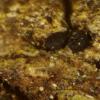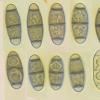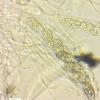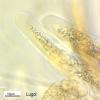
29-12-2025 17:01
Gernot FriebesHi,I'm looking for help with this hyphomycete with

29-12-2025 08:30
Hello.A tiny ascomycete sprouting under Juniperus

29-12-2025 10:15
Hulda Caroline HolteHello, I found and collected this propoloid ascom

29-12-2025 09:38
Oskari VirtanenHi,could anyone help me identify this, I suspect P

28-12-2025 12:08
Margot en Geert VullingsThis possible Karstenia was found on the bark of d

21-12-2025 21:32
Pol DebaenstHello, Garden, Burgweg 19, Veurne, BelgiumOn 10/1

26-12-2025 21:19
Arnold BüschlenPithyella chalaudii Priou. Ist als Bryoparasit in

21-12-2025 09:32
Hello.A tiny ascomycete found embedded in wood in

18-12-2025 21:17
Pol DebaenstThe identification took me to Byssonectria deformi
Spores of the one collected on Betula: (20.4) 21.6 - 24.2 (26.3) × (9.1) 9.2 - 10.5 (10.9) µm; Q = (2.1) 2.14 - 2.5 (2.8) ; N = 26; Me = 22.9 × 9.8 µm ; Qe = 2.3
Spores of the one collected on Sorbus: (18) 19.7 - 23.3 × (8.8) 9.1 - 9.6 (9.7) µm; Q = (1.9) 2.1 - 2.4 (2.5) ; N = 7; Me = 20.9 × 9.3 µm ; Qe = 2.2
I have no idea, so any help is welcome!
Greetings Per
No, Apiorhynchostoma doesn't fit.
I have already found this fungus on Betula and Sorbus, but it's yet unnamed.
Sorry,
Alain
Alain, that's very interesting. I have been in contact with Geir Mathiassen, he has also found this fungus in Finnmark, Norway. He found it on Betula pubescens and Alnus incana and suggested that it might be an undescribed species in a publication 2012 page 12 and 30 with a pic of the spores fig 78:
http://www.artsdatabanken.no/File/1049/Mathiassen%20G.%20og%20Granmo%20A.%202012%20Sluttrapport%20for%20Artsprosjektet.%20Sekksporesopper%20i%20Finnmark%202010%E2%80%932011.%20Troms%C3%B8%20Museum,%20Universitetsmuseet%202012,%20ADB%2056-09,%20Prosjekt%2070184216
Where did you find it?
Per
Yes, same fungus apparently.
A very very interesting paper for who likes pyrenomycetes.
2 remarks about Hysteriaceae :
Gloniopsis praelonga shown is not different from Hysterobrevium smilacis, now named H. curvatum.
and also : H. acuminatum= H. angustatum.
Incredible land they have in Finmark !
Thank you,
Alain
Thank you for the remarks on Hysteriaceae. I am doing survey on Fungi in Rotlia Naturreservat, that is where I found the fungus we have discussed here. I also found Hysterobrevium smilacis/ curvatum/ praelonga there and have made some notes about the names and synonymity. In the report I am going to write about Ascmycetes in Rotlia Naturreservat the unnamed Dothideomycetes will be shortly mentioned and that you apparently have found the same fungus. I guess you found it in France?
Thanks
Per

Andy
Per

If your material consists of 15-20 fruiting bodies, send it to me and my technician can sequence it for you. We only need 5-10 fruiting bodies to extract DNA.
Best,
Andy
thank you very much for your generous offer! Unfortunately the material consists of only the 3 fruit bodies, you can see on the first photo, and it looks like the small one is empty. But I'll go and try to find more next week.
Thank you,
Per
Hi Andy,
Happy to read you.
My record was from France. I had got many ascomata, but it was collected in 2013.
It's located in mountains (alt. 1300 m, probably covered by snow now). Next year I will be able to collect it.
Best wishes,
Alain

It would be best to send me material from both localities so we can compare their ITS sequences and better understand mycogeography. Next month or next year is fine. This would be an interesting new find!
Best,
Andy
"I finally sequenced your PV-R351 collection and the results are odd. The ITS-LSU region BLASTs to Umbilicaria in GenBank, but there is a Gloniopsis at the bottom of the list with about the same query coverage and similarity as Umbilicaria. I tried BLASTing the ITS and LSU separately and I get similar results - either an Umbilicaria or a Hysteriales. The sequences were good although the material was not in great condition. Is it possible that this is a lichen?"
Thank you very much, Andy!
All the best
Per



